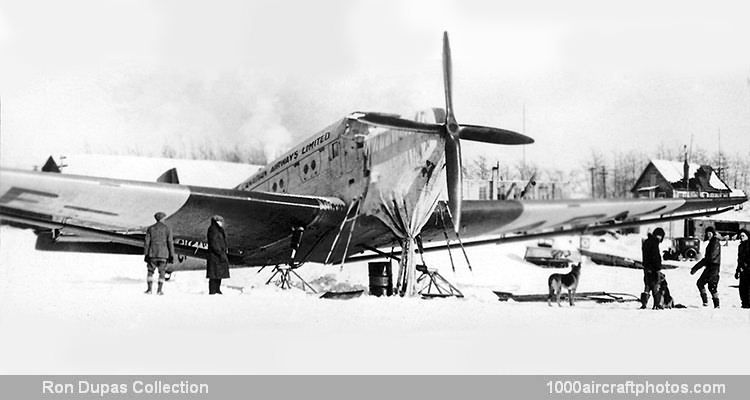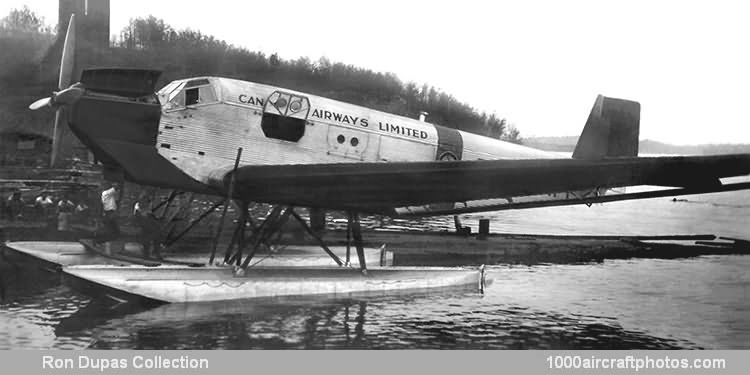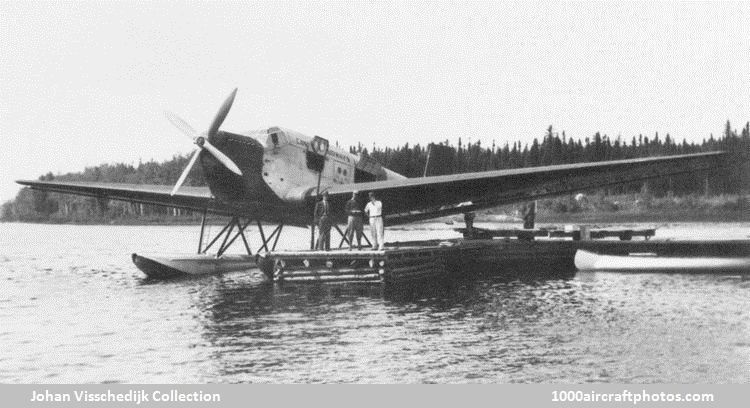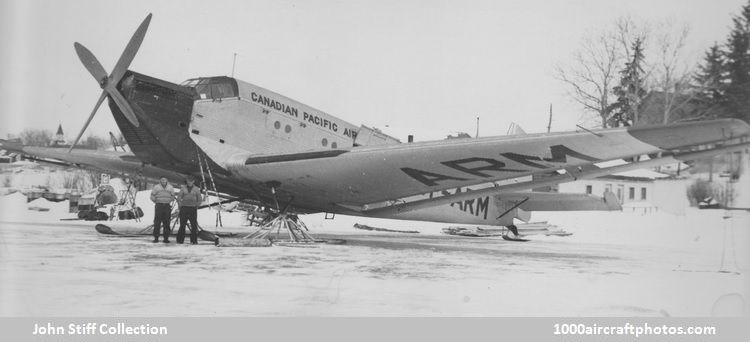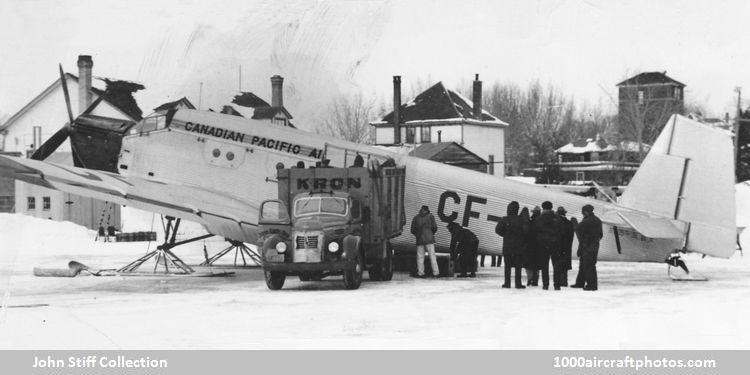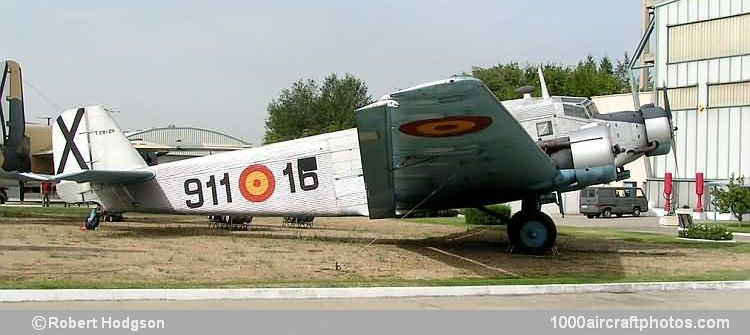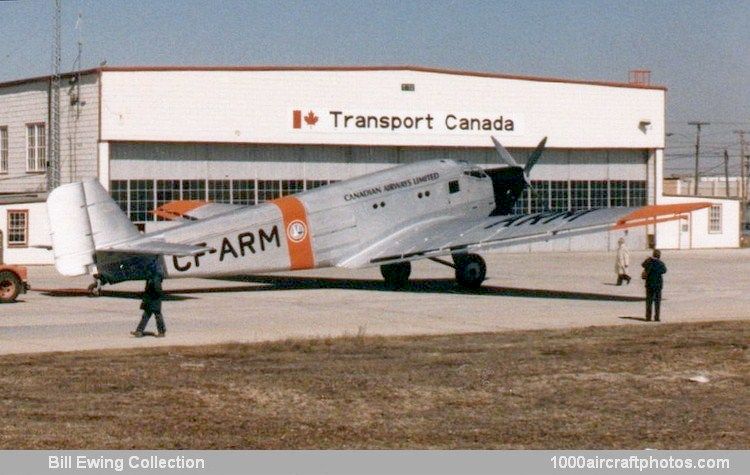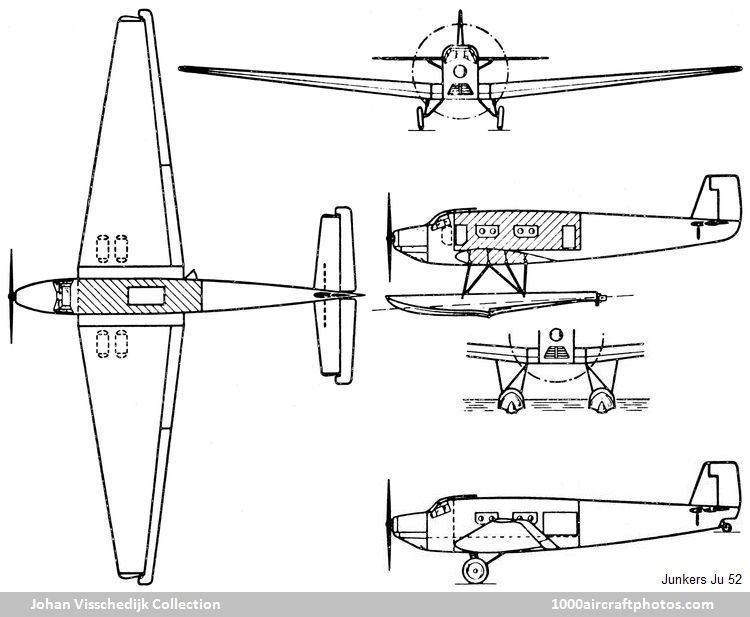10/31/2013. Remarks by
Johan Visschedijk: "With the single-engine cargo aircraft Ju 52, the designers at Junkers in Dessau, Germany, used the experiences with the W 33 and W 34. It should meet the specific conditions of profitable air cargo transport, and be not only able to just take off and land from makeshift airfields, but it also be suitable to handle a load of more than two tons.
The plane was a cantilever low-wing monoplane of typical Junkers design with corrugated steel covering. Striking were the robust chassis and the trapezoidal wings with over the entire length the Junkers Doppelflügel (double wing), a narrow control surface, with its outer section functioning as the aileron, and the inner section functioning as a flap. The landing gear was interchangeable with wheels, floats or snow skis, which, as in many other previous Junkers types, ensured the versatile availability. Fuel was stored in several tanks in the wings.
With the selected moderate wing loading, the Ju 52 had excellent and secure flight characteristics. The wagon-like box-hull with its large side walls demonstrated the aircraft as a railcar in the air, while the double wing allowed a low landing speed for tight and bumpy places. Up to 1933, six examples of the Ju 52 were built, and, as had long since been the rule in Dessau, variously motorized.
The first Ju 52 was given the serial number 4001 and was equipped as Ju 52 ba with an 800 hp Junkers L 88 engine, and it first flew on October 13 1930. After initial testing the engine was replaced by a 690 hp BMW VIIau, the aircraft was redesignated Ju 52 be and registered D-1974. On February 17, 1931, it was presented at the Lufthansa Berlin-Tempelhof Airport as a "flying furniture van".
In June 1933, the aircraft was taken over by the Luftfrako Air Express of Berlin, but only one month later returned to the Junkers factories. It is believed that the testing of the Ju 52 in regular service should be performed by Luftfrako, but that it did not meet the requirements. With modified wings in a light arrow shape and improved rudders, three more aircraft were built (construction numbers 4002, 4003 and 4004) and initially equipped with a 690 hp BMW VIIau engine, these aircraft was designated Ju 52 ce.
The c/n 4002, registered D-2133, remained in the Junkers factory and was later used to collect flight performance data when fitted with a Junkers 4 engine running on Rohöl (crude oil), this version was designated Ju 52 di; in 1934 it was reregistered D-USUS. The c/n 4003 was soon re-engined with the improved BMW VIIa engine and equipped with floats it was delivered to a to a maritime squadron.
The c/n 4004, registered D-2317, was sold to the Deutsche Verkehrsfliegerschule (German Transport Pilot School) in September 1932, but later that year it was transferred to the Junkers subsidiary Aktie Bolaget Flygindustri in Limhamn, Sweden, to be converted to a torpedo-bomber. Reflown under the Swedish registration SE-ADM it returned to Germany and torpedo dropping was tested at Travemünde. After these tests were concluded the aircraft was again registered D-2317.
The c/n 4005, registered D-2356, emerged as the single Ju 52 cai, fitted with an 800 hp BMW IXau engine. In February 1933, this aircraft was handed over to the
RDL, and flew at the RDL test site at Staaken. In May 1933 it was destroyed by a fire.
Junkers Ju 52 ce in service with Canadian Airways (CF-ARM) (
Johan Visschedijk Collection)
Junkers Ju 52 ce in service with Canadian Airways (CF-ARM) (
Johan Visschedijk Collection)
The c/n 4006, registered D-2133, reverted to the original empennage form, while the engine was a 750 hp Armstrong Siddeley Leopard, the designation was Ju 52 ce. After testing, the landing gear was replaced by floats and the aircraft was delivered to the Canadian Airways Limited, on October 26, 1931 it was registered in Canada as CF-ARM. In 1936 the aircraft was re-engined with an 825 hp Rolls-Royce Buzzard and it was redesignated as Ju 52 cao.
Junkers Ju 52 ce in service with Canadian Pacific Airlines (CF-ARM) (
John Stiff Collection)
Junkers Ju 52 ce in service with Canadian Pacific Airlines (CF-ARM) (
John Stiff Collection)
It became part of the Canadian Pacific Airlines (CPAL) aircraft fleet in 1942 when Canadian Airways merged into the newly formed CPAL. It flew on in Canada until 1947 and after 16 years of service it was scrapped at Winnipeg, Manitoba, on May 16, 1947."
CASA 352L (T.2B-211) (
Robert Hodgson Memorial Collection)
12/15/2021. Remarks by
Johan Visschedijk: "A replica of CF-ARM is on display at the Royal Aviation Museum of Western Canada (up to 2014 known as the Western Canada Aviation Museum) at Winnipeg, Manitoba, Canada. The aircraft was originally built in Spain as a
CASA 352L and was accepted by the Spanish AF in June 1949, coded T.2-148, later T.2B-148. It was withdrawn from service after 2,828 flight hours on November 26, 1975. In February 1977, it was bought by Dolph D. Overton of Kenley, North Carolina, USA, who had it registered as N99234. On July 14, 1978 it arrived at Strathallan, Scotland, nine months later it was delivered to the Wings and Wheels Museum in Orlando, Florida, USA, where it was put on display.
Junkers Ju 52 ce replica (
"CF-ARM") (
Ewing Collection)
On January 25, 1982 it was sold to the Western Canada Aviation Museum, and registered C-GARM it was flown to Winnipeg on May 11, 1982. Bristol Aerospace Ltd. at Winnipeg converted the aircraft to the single-engined Ju 52, the Canadian Airways CF-ARM replica was rolled-out on April 1, 1985."
